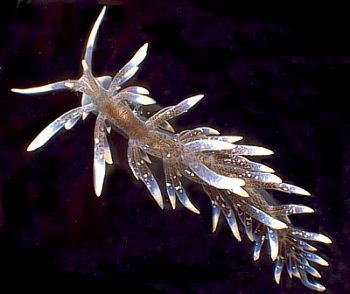
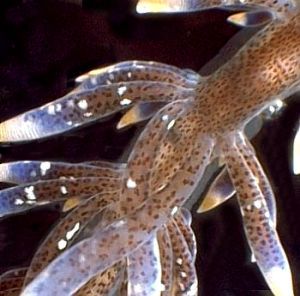
Phyllodesmium macphersonae
(Burn, 1962)
Order: NUDIBRANCHIA
Suborder: AEOLIDINA
Family: Glaucidae
DISTRIBUTION
Tropical Indo-West Pacific. It is also found throughout Australia even in the cooler temperate waters of Victoria and Tasmania.
PHOTO
Lower photo showing brown patches beneath the skin which are 'gardens' of one-celled plants (zooxanthellae) which the nudibranch keeps alive and functioning in its body. Middle Reef, Minnie Waters, northern New South Wales, Australia. March, 1966. Photo: G. Biddle.
The body is translucent with scattered microscopic iridescent patches givin a bluish-purple sheen to the body in certain lights. Most of the body, cerata and tentacles have scattered brown patches. The uper part of the cerata and tentacles is white, often with a diffuse yellow band, and below this white region is a bluish band. In some animals the blue and yellow are absenr or only faintly visible. Species of Phyllodesmium usually feed on octocorals and many retain, and keep functioning in their bodies, symbiotic zooxanthellae from the octocorals they feed on. (See page on Solar Powerd Sea Slugs). We do not know what P. macphersonae feeds on, but its anatomy shows many adaptations for 'farming' zooxanthellae in its body. The brown patches which form such a prominent element of its colour pattern are in fact 'gardens' of zooxanthellae, arranged in special branches of the digestive system, so that they are able to get sufficient sunlight for photosynthesis. It grows to about 15mm in length.
References:
• Rudman, W.B. (1981) The anatomy and biology of alcyonarian feeding aeolid opisthobranch molluscs and their development of symbiosis with zooxanthellae. Zoological Journal of the Linnean Society, 72: 219-262.
• Rudman, W.B. (1991) Further studies on the taxonomy and biology of the octocoral-feeding genus Phyllodesmium Ehrenberg, 1831 (Nudibranchia: Aeolidoidea). Journal of Molluscan Studies, 57(2): 167-203.
Rudman, W.B., 2001 (April 29) Phyllodesmium macphersonae (Burn, 1962). [In] Sea Slug Forum. Australian Museum, Sydney. Available from http://www.seaslugforum.net/find/phylmacp
Related messages
Re: Phyllodesmium macphersonae from sthn Queensland
August 8, 2008
From: Gary Cobb
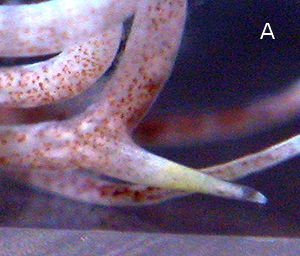
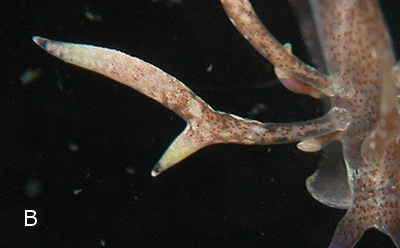
Concerning message #21756:
Hi Bill,
In regards to Phyllodesmium macphersonae cerata, I have attached two shots from two animals that, to me, clearly show cerata that are 'forked' [photos A, B]. And yes the appearance of forked cerata due to underlaying cerata are an illusion. Not all animals have this but the next one we find I will get some microscope shots for you to see.
Locality: Old Woman Island, Mooloolaba, Sunshine Coast, 12 m, Queensland, Australia, Pacific Ocean, 22 December 2005, Subtidal. Length: 6-18 mm. Photographer: Gary Cobb.
Cheers
Gary
gary@nudibranch.com.au
Cobb, G.C., 2008 (Aug 8) Re: Phyllodesmium macphersonae from sthn Queensland. [Message in] Sea Slug Forum. Australian Museum, Sydney. Available from http://www.seaslugforum.net/find/21774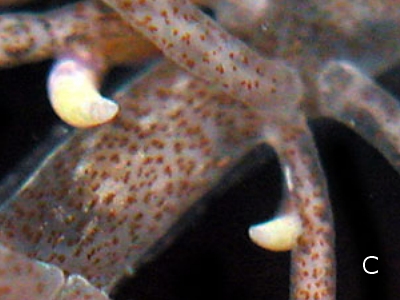
Thanks Gary,
Certainly these two close-ups show strange branches off the main ceras. I looked carefully at the photos in your other message [#21756] and was pretty convinced that the apparent branching was from the tip of an underlying ceras. I've included here [ Photo C] a slight enlargement of the highest res photo you sent in your earlier message and I am sure the 'branch' in the lower right of the photo is the tip of a smaller underlying ceras. There is no indication of the digestive gland duct branching and I can see the unbroken left edge of the upper ceras. However the 'branch' in the upper left of that photo could well be a real branch.
It would be interesting to see microscope shots, just to see if there is in any indication of the digestive gland duct branching into the ceratal branch. Looking at your photo B, both the large cerata have a small ceras right beneath them whose tips could be mistaken for branches. So it looks as though some 'branches' can be illusions, and some can be real. As to why this branching occurs, I have no idea. The specimens in your photos were from two years apart so it seems to be a local phenomenon. If this species is a direct developer then perhaps it is a local genetic oddity, or perhaps there is some local pollutant which is interfering with their development.
Best wishes,
Bill Rudman
Phyllodesmium macphersonae from sthn Queensland
August 6, 2008
From: Gary Cobb
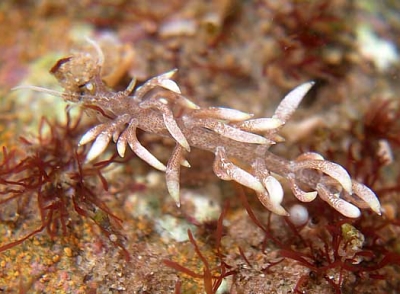
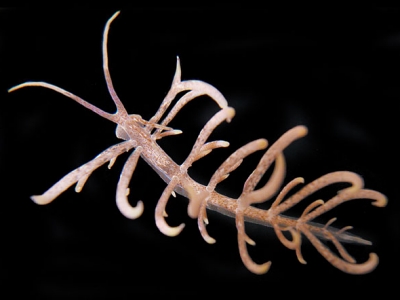
Concerning message #15896:
Hi Bill and everyone!
Here are some records of Phyllodesmium macphersonae found here on the Sunshine Coast. This species is fairly common here as we have discovered at Old Woman island, on the bottom, mixed sand and rock 15m.
The interesting thing is that all the animals we have found here have 'forked' cerata. An accessory papilla always toward the anterior end.
Locality: Old Woman Island, Mooloolaba, Sunshine Coast, 15 m, Queensland, Australia, Pacific Ocean, 01 December 2007, Subtidal. Length: 6-18 mm. Photographer: Gary Cobb.
Cheers
Gary Cobb
gary@nudibranch.com.au
Cobb, G.C., 2008 (Aug 6) Phyllodesmium macphersonae from sthn Queensland. [Message in] Sea Slug Forum. Australian Museum, Sydney. Available from http://www.seaslugforum.net/find/21756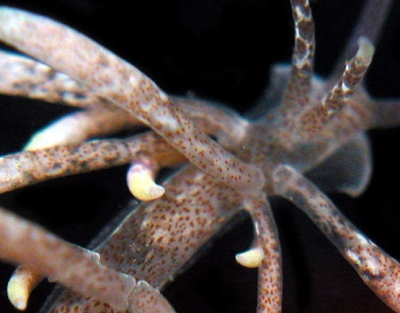
Dear Gary,
Thanks for these photos. As you can see from the brown patches, which are clusters of zooxanthellae, P. macphersonae is one of the species of Phyllodesmium which is solar powered. Those species we have information for get their zooxanthellae from the soft-corals on which they feed. However P. macphersonae remains a puzzle because we have never found it feeding, or even associated with a likely food item. Since you say it is quite common on the Sunshine Coast perhaps you could add it to your 'to do list' and see if you could photograph it with some likely food items.
Concerning the apparently 'branched' cerata. This is a trick of the photographs. This species has the cerata in each row almost exactly underneath the ones above. What you can see here are the tips of the lower cerata poking out from under the uppermost ceras in each row.
Best wishes,
Bill Rudman
Phyllodesmium macphersonae from Jervis Bay
February 22, 2006
From: Leander Wiseman
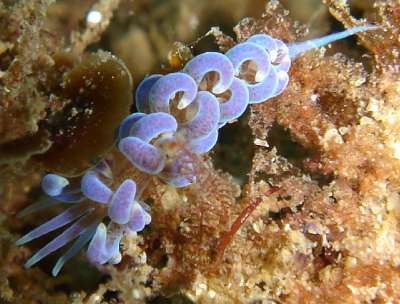
Bill,
In an earlier post you mentioned looking for more images of Phyllod. macphersonae and in particular the substrate.
These pictures are of an individual found in about 12 m at the Nursery, Bowen Island, Jervis Bay on the 31/3/2005.
Locality: 'The Nursery', Bowen Island, Jervis Bay, 12 m, NSW, Australia, 31 March 2005, Bommie. Length: 15-20 mm. Photographer: Leander Wiseman.
Leander Wiseman.
leander.wiseman@yahoo.com
Wiseman, L.M., 2006 (Feb 22) Phyllodesmium macphersonae from Jervis Bay. [Message in] Sea Slug Forum. Australian Museum, Sydney. Available from http://www.seaslugforum.net/find/15896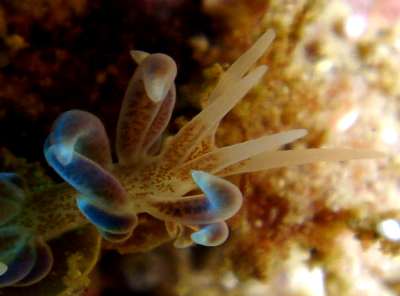
Dear Leander,
I am always asking for the impossible - but I am forever optimistic. What I am hoping to find is what soft coral Phyllodesmium macphersonae is feeding on. I am sure it is one of the solar-powered species. In your close-up alongside, the brown specks are symbiotic plants called zooxanthellae, which I suspect the nudibranch gets from some soft-coral it feeds on. But I am having trouble finding it feeding - which is not surprising since the animals seems quite uncommon, and its prey may be quite small itself.
Best wishes,
Bill Rudman
Re: Phyllodesmium from Jervis Bay
October 7, 2005
From: Sue Newson
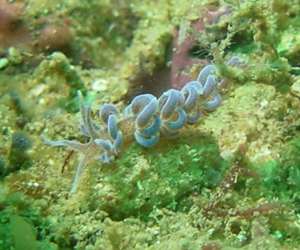
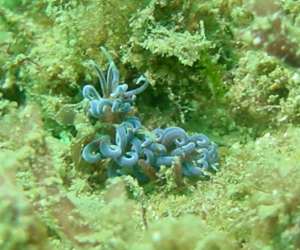
Hi Bill,
I just read a previous message [#14901] posted by Paul Osmond asking for an ID on a Phyllodesmium species from Jervis Bay. I have seen this nudibranch on several occasions over the years. This is a photo of the most recent sighting of it.
Locality: Jervis Bay, New South Wales, Australia. Depth: 17 m. Length: 10 mm. 23 September 2005. rocky reef. Photographer: Sue Newson
On this occasion there were five individuals in the same spot. They have been seen on the rocky reefs from both the south and north sides of the bay. Each occasion I have seen them, have been in a 15 - 20 m depth range. I have always identified them as Phyllodesmium serratum.
Sue Newson
suenewson@optusnet.com.au
Newson, S.T., 2005 (Oct 7) Re: Phyllodesmium from Jervis Bay. [Message in] Sea Slug Forum. Australian Museum, Sydney. Available from http://www.seaslugforum.net/find/14934Dear Sue,
The genus Phyllodesmium is very interesting because the species show almost evry stage in the evolution from 'normal' animals which get their nutrition solely from the food they eat to solar powered 'plant animals' which keep single-celled plants alive in their bodies, and get some of their nutrition from the photosynthetic activity of the plants. We can therefore use the morphological adaptations, if any, the animals have for this symbiosis, as a way of identifying them from one another. In typical P. macphersonae, as well as the yellow and white-tipped cerata, there are brown patches all over the body wall and the ceratal wall, which represent small 'gardens' of plant cells [zooxanthellae]. They are not so clear in yours, or Paul Osmond's photos, but if you look at Eric Schloegl's photo [#4250] they are clearly visible. Phyllodesmium serratum on the other hand is one of the species which does not contain zooxanthellae, so it can't be that. At this stage I have considered this animal to be a temperate water form of P. macphersonae, which is found throughout the tropical Indo-west Pacific.
I am intersted to hear you find it not uncommonly. It is the only species around here that I have been unable to find what it feeds on. Finding a number of animals in one spot sounds promisng. It is most likely feeding on a species of soft coral, and as I suspect it obtains its zooxanthellae from its soft-coral food, the soft coral is likely to be dark brown, or grey in colour or to have dark specks. Next time you come across the animal I would love some close-up photos, especially if it is on a soft coral.
Best wishes,
Bill Rudman
Phyllodesmium macphersonae? from Jervis Bay, NSW, Australia
October 5, 2005
From: Paul Osmond
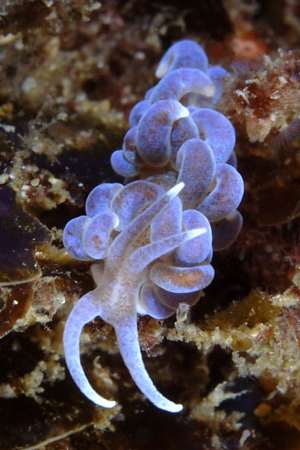
Normally I make an educated guess on the species of nudibranch, but I am totally unsure of this one, so if you could identify this one for me it would be appreciated.
It was found at about 20m on the Point Perpendicular dive site in Jervis Bay, New South Wales, Australia. Water was cold - about 12 degrees.
Locality: Jervis Bay, NSW, Australia. Depth: 20 m. Length: 40 mm. 21 August 2005. Rocky coral reef. Photographer: Paul Osmond
Paul Osmond
marriard@deepseaimages.com
Osmond, P.T., 2005 (Oct 5) Phyllodesmium macphersonae? from Jervis Bay, NSW, Australia. [Message in] Sea Slug Forum. Australian Museum, Sydney. Available from http://www.seaslugforum.net/find/14901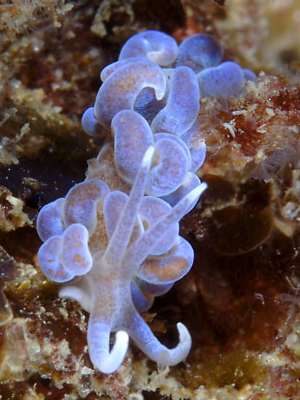
Dear Paul,
I'm afraid 'educated guesses' are what we have to resort to sometimes. I am identifying this as Phyllodesmium macphersonae but I can't say I'm 100% sure. That species usually has distinct brown patches of zooxanthellae visible all over the skin, and yellow tips to cerata and head tentacles - and at 40 mm it is a bit big. But then again, perhaps this is what the species looks like when it reaches a large size.
Best wishes,
Bill Rudman
Phyllodesmium macphersonae - first feeding record
January 25, 2002
From: John Chuk
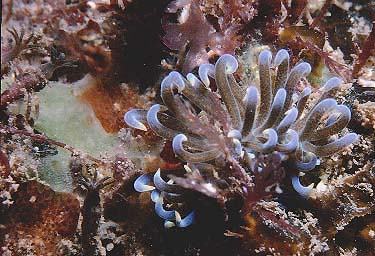
Dear Bill,
Looking back through my slides I found one of Phyllodesmium macphersonae apparently feeding on a soft coral. The specimen was found on a dive at Flinders pier, Victoria, Australia, on 21st April 1995. My notes from the time describe it as being found feeding on small, dark, soft coral polyps on a pier pylon at a depth of 3m.
The first image is an in situ shot of the specimen feeding. It is not very distinct as the specimen was somewhat hidden in the profuse growth on the pylon. This growth included red and brown algae, sponges, bryozoans, and the soft coral. Several polyps of the soft coral can be seen to the left of the specimen. They are dark grey-green in colour which does suggest that they contain zooxanthellae. If so they may be the source of the zooxanthellae found in the nudibranch.
The second image is a composite enlargement of several of the soft coral polyps seen in the first. They have the typical pinnate tentacles of soft corals. The polyps are up to 3mm in diameter and 3mm in height. They are supported on a stem. I am unable to identify them.
The third image was taken of the specimen after removing it from the pylon and placing it on the bottom beneath the pier. It measured 18mm in length and certainly looks packed with zooxanthellae. At the time I took these shots I didn't know that any nudibranch used zooxanthellae as an energy source. It is somewhat fortunate that I'm in the habit of taking in situ shots before moving an animal!
Best wishes,
John
jchuk@giant.net.au

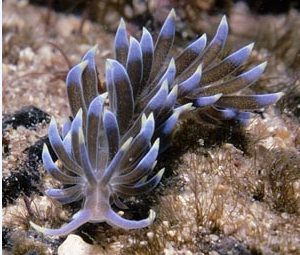
Dear John,
This is indeed another wonderful find. I have long puzzled over what this species eats. As you surmised it does indeed contain zooxanthellae and is one of the species in the genus in which the digestive ducts have developed a complex system of branching so that zooxanthellae can be placed in little 'gardens' in all parts of the skin which receive sunlight. This is the first record we have of its food. I will need to check its identity, but it reminds me it seems to be Erythropodium hicksoni [formerly known in Australia as Paryerythropodium] which is an encrusting soft coral forming thin leathery mats over large areas of the low intertidal and upper sublittoral regions of rocky shores in temperate Australia. It is often overgrown with algae, sponges and other growths. I'll let you know when I get this soft-coral's identity confirmed.
Best wishes,
Bill Rudman
Phyllodesmium macphersonae? from Japan
September 20, 2001
From: Nishina Masayoshi
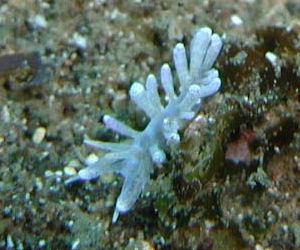
Dear Dr.Rudman,
I wonder this is Phyllodesmium macphersonae?
16 Dec,2000
Loc: Hachijo Island
Length: 20mm
Photo by Jun Imamoto
Best Regards,
Nishina Masayoshi
nishina@wips.co.jp
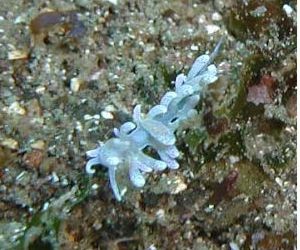
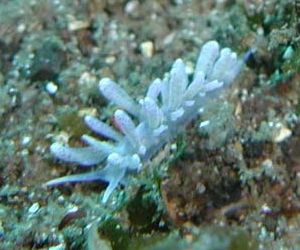
Dear Nishina,
It certainly looks quite like it, but sometimes it is a bit difficult to be sure without a look at the live animal or its anatomy.
Best wishes,
Bill Rudman
Phyllodesmium macphersonae from Sydney
April 30, 2001
From: Erik Schloegl
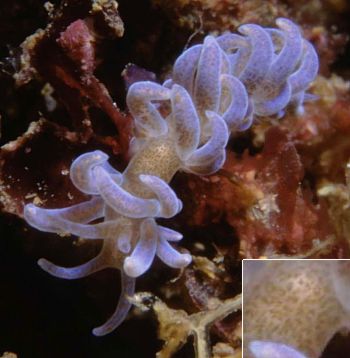
Dear Bill,
The attached photo was taken on 18 February, 2001, just south of the entrance to Sydney Harbour [New South Wales, Australia]. The depth was 23m, the substrate rocky reef, and the water temperature 22 C. The animal was about 8mm long. Can you please help me with an ID?
Thanks,
Erik
Erik.Schlogl@uts.edu.au
Schloegl, E., 2001 (Apr 30) Phyllodesmium macphersonae from Sydney. [Message in] Sea Slug Forum. Australian Museum, Sydney. Available from http://www.seaslugforum.net/find/4250Dear Erik,
You certainly have the ability to find species I haven't got on the Forum! This is Phyllodesmium macphersonae, one of a genus of aeolids which feed on soft corals, and some of which are 'Solar powered'. I have included as an inset to your photo, a magnified veiw of part of the body to show the characteristic brown patches. These patches are little 'gardens' of one-celled plants (zooxanthellae) that the aeolid keeps alive in its body so that they continue to photosynthesise and produce nutrients for the Phyllodesmium. We still don't know which soft coral P. macphersonae feeds on, but assume it gets the zooxanthellae from a soft coral which also has them living symbiotically in its tissue. So if you run across P. macphersonae again, any information on its food would be of interest.
Best wishes,
Bill Rudman
